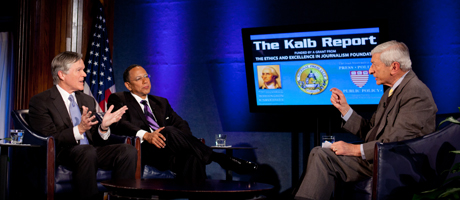By Menachem Wecker
Monday night’s Kalb Report, titled All the News That’s Fit to Print: Behind the Scenes at The New York Times, was packed with all the sorts of details host and GW James Clark Welling Presidential Fellow Marvin Kalb always manages to tease out.
Guests Bill Keller, executive editor of The New York Times, and Dean Baquet, the paper’s Washington bureau chief, told the audience at the National Press Club that 400 of the Times’ 1,100 employees are reporters. The rest are “editors, photographers, videographers, web producers and a whole panoply of clerks,” according to Mr. Keller.
Mr. Baquet said his bureau employees about 45 people, 28 or 29 of which are reporters.
Although the printed paper’s daily subscription is 1 million – compared to 50 million visitors to the website each month – Mr. Keller said the print edition “still supplies the overwhelming majority of the revenues that keep the company going.”
As Michael Freedman, executive producer of the Kalb Report, explained after the show, Mr. Kalb often reserves his toughest questions for the news outlets and newsmen he most respects.
The New York Times was no exception.
“I don’t know about you, but I am grateful for three things every day,” Mr. Kalb said in his introduction to the show. “That I get up in the morning, that I live in a free country and that copies of two newspapers are dropped off in front of my house every day, seven days a week. More reliable, I’ve found, than the United States Postal Service.”
One of the two newspapers Mr. Kalb said he receives – and described as “a morning miracle” – is the Times, which he called “arguably the most respected newspaper in the United States, and certainly one of the best in the world.”
But if he seemed a bit gushy in his introduction, Mr. Kalb was certainly not star struck. He asked his guests to account for the seven minutes the Times’ website erroneously stated that Rep. Gabrielle Giffords (D-Ariz.) had died, and asked several times for the two editors to justify the paper’s decision to publish less of what he described as hard news, instead opting for more features and commentary.
“There’s no such thing as an OK mistake … especially when it’s one of that magnitude,” Mr. Keller said of the misinformation about Ms. Giffords.
When people talk about hard news, they usually mean events, Mr. Baquet said, responding to Mr. Kalb’s second question.
“The president did something today; something concrete happened. There was an accident, a disaster of some sort. That’s what people generally talk about when they mean hard news,” he said. “But that doesn’t cover a whole realm of enterprise, investigative news that is not lying out there to be harvested easily by reporters. It requires time and digging, but … is some of the most worthwhile journalism we do.”
So the cat-and-mouse game went for the hourlong program, and for a lengthy question-and-answer period, which was broadcast live by C-Span.
Mr. Freedman, executive director of the GW Global Media Institute and professor of media and public affairs, said the evening demonstrated that the challenges facing journalism are “daunting.”
“Maintaining superior editorial standards in a multitasking world with deadlines every minute is, at best, a work in progress,” he said. “Meantime, the pathway to future financial success remains uncharted, and all of us who value journalism will be watching closely as The New York Times rolls out its pay wall plans this year.”
The unanswered question, “literally and figuratively,”according to Mr. Freedman, is whether readers will put their money where their computer mice are, and actually pay to read the Times online.
“Few publishers are sounding an alarm that our quality journalism could be in jeopardy if a successful business model isn’t created sooner rather than later for new media platforms,” he said.
“In order for this to work, the public will need to realize that quality journalism requires the financial foundation to support a substantive news gathering organization,” he said. “In the end, we’ll get what we pay for.”


